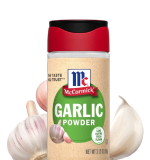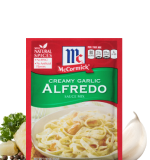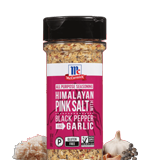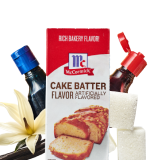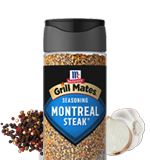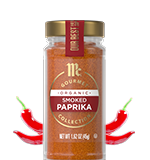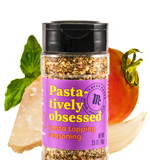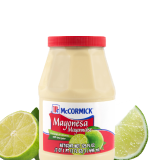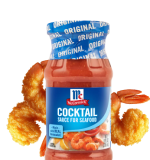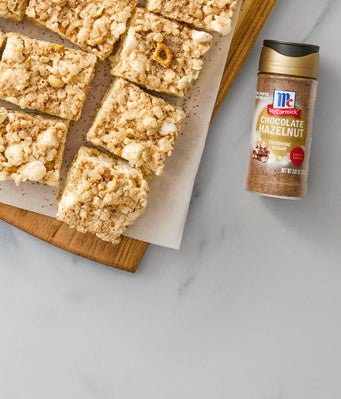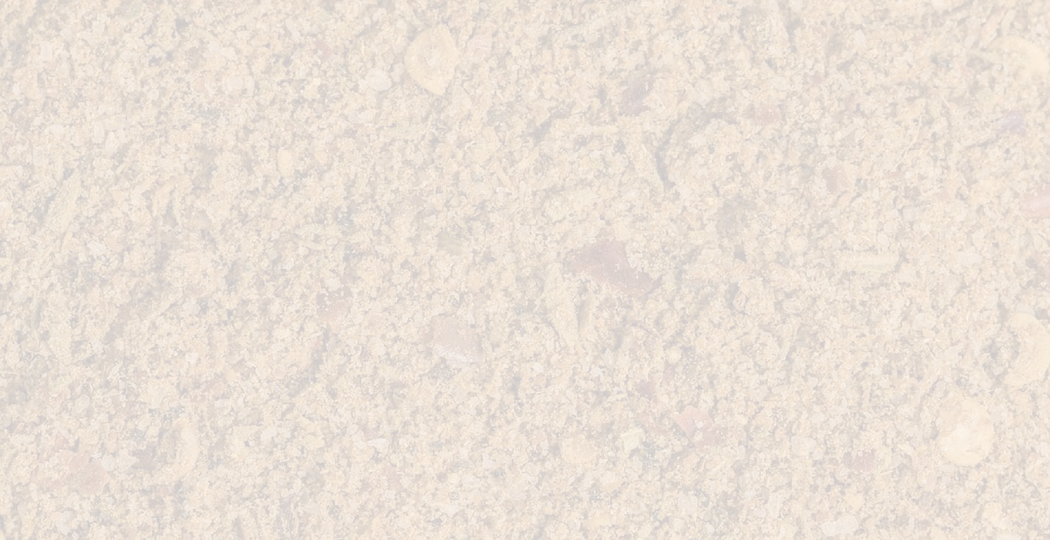

FAQ
Find answers to commonly asked questions about McCormick's products, recipes, shipping, nutrition, and more. Explore helpful information on spices, herbs, and flavoring solutions!
McCormick is aware that some websites and social media accounts are falsely claiming that we are running promotional giveaways. These claims appear to be associated with scams designed to fraudulently obtain money or personal information. If you see a promotional giveaway that is not promoted on McCormick-owned channels, websites, or mobile applications, we recommend that you not interact with them.
Allergen / Ingredients
We are aware of allergies and sensitivities and will always declare the following ingredients on our label in the ingredient statement - they will never be hidden under the notations of "spices" or "natural flavors":
•Wheat
•Milk & Milk Products
•Peanuts
•Tree Nuts
•Egg
•Soy
•Shellfish
•Sesame (for products made beginning January 2023)
•Fish
•Yellow Dye #5 (Tartrazine) •Monosodium Glutamate or MSG
•Sulfites over 10 ppm
•Gluten containing grains - including barley, rye, oats, spelt, triticale, and kamut
If no ingredient statement appears on the product label, then the products is as it appears in the product name (e.g. black pepper). This labeling policy is compliant with US or Canadian food labeling laws, as appropriate.
If any product has a Gluten Free claim, the product and the manufacturing line has been validated Gluten Free.
Our facilities have allergen, sanitation, and hygiene programs in place. Our employees follow good manufacturing practices and are trained in the importance of correct labeling and the necessity of performing thorough equipment clean-up and change over procedures to minimize cross-contact of ingredients.
It is important that you read the ingredient statement on your package at the time of purchase to ensure accurate, up-to-date information, as product formulas may change. While we list all ingredients on our packaging in accordance with regulatory guidelines, some ingredients may be included under broader terms like “spices” or “natural flavors”. If you have concerns about any ingredients, we encourage you to contact us directly so we can look into it for you.
Gluten and gluten products, when present, will always be declared on the product label by the common name of the gluten source such as “barley”, “wheat”, “rye”, “oats” or “triticale”.
It is important that you read the ingredient statement on your package at the time of purchase to ensure accurate, up-to-date information, as product formulas may change.
Our McCormick facilities have allergen, sanitation, and hygiene programs in place. Our employees follow good manufacturing practices and are trained in the importance of correct labeling and the necessity of performing thorough equipment clean-up and change over procedures to minimize cross-contact of ingredients.
If any product has a Gluten-Free claim, the product and the manufacturing line has been validated Gluten-Free
If no ingredient statement appears on the product label, then the products is as it appears in the product name (e.g. black pepper). This labeling policy is compliant with US food labeling laws.
The term “natural flavors” can vary depending on the product. We use a variety of natural flavors, all of which are derived from natural sources.
The collective terms “spices” or “spices and herbs” means any aromatic vegetable substance in the whole, broken, or ground form such as allspice, basil, bay leaves, cinnamon, ginger, turmeric, sage, etc.
For proprietary reasons, we cannot provide details on the ingredients used in “natural flavors” or “spices” or “spices and herbs”. However, if there is a specific ingredient of concern, we can advise on its presence or absence within our product.
We are aware of allergies and sensitivities and will always declare the following ingredients on our label in the ingredient statement - they will never be hidden under the notations of "spices" or "natural flavors":
•Wheat
•Milk & Milk Products
•Peanuts
•Tree Nuts
•Egg
•Monosodium Glutamate or MSG
•Soy
•Shellfish
•Sesame (for products made beginning January 2023)
•Fish
•Yellow Dye #5 (Tartrazine)
•Sulfites over 10 ppm
•Gluten containing grains - including barley, rye, oats, spelt, triticale, and kamut
It is important that you read the ingredient statement on your package at the time of purchase to ensure accurate, up-to-date information, as product formulas may change. While we list all ingredients on our packaging in accordance with regulatory guidelines, some ingredients may be included under broader terms like “spices” or “natural flavors”. If you have concerns about any ingredients, we encourage you to contact us directly so we can look into it for you.
You can find nutrition information posted on most of our products on our website. Just visit the “Products” section of our website
Nutrition Information should be available for most items, with these exceptions:
•Spices/Herbs: Spices and Herbs are not high in nutrient values and they do not make a significant contribution to the nutritional content of foods on a per-serving basis of one-fourth teaspoon. Spices and Herbs are naturally low in calories, fat, sugar and sodium.
•Extracts: Extracts do not make a significant contribution to the nutritional content of foods on a per-serving basis. However, they do contain small amounts of calories and sugars. Based on the standard FDA serving size of one-fourth teaspoon, most contain less than 5 calories and 1 gram of sugar.
Keep in mind that while Spices, Herbs and Extracts do not provide nutritional content, they do play an extremely valuable role in good nutrition by enhancing the flavor and appeal of foods which are nutritionally important.
Sea salt has a similar level of sodium to table salt and is not recommended as a low salt substitute.
Because we are sensitive to consumers who must limit their intake of salt/sodium, we would like to let you know that all our single spice and herb products are salt free. If there is salt in the formula of a product, it will be listed in the ingredient statement.
All McCormick® Cinnamon comes from the cassia family of cinnamon (Cinnamomum cassia). It is primarily imported from Indonesia and is the most common form of cinnamon in the United States. McCormick Gourmet and Gourmet Organic Saigon Cinnamon are from Cinnamomum loureirii, primarily sourced from Vietnam.
Coumarin is a naturally occurring compound present in several plants, not just cinnamon. Examples include licorice, strawberries, cherries, apricots, and lavender. There is no scientific evidence of any adverse health effects resulting from the normal consumption of cinnamon.
McCormick recognizes the USDA Federal Standards governing the labeling of "organic" foods, and will follow this standard for any organic products we market.
“100% Organic” means that the product must contain 100% organically produced ingredients with no pesticides or animal fertilizers used. An organic product is obtained through adherence to organic standards at the agricultural production level, which must be maintained through handling to the point of final sale, in order for the final product to be labeled and/or marketed as organic.
Cooking / Substitution
If you run out of an ingredient at the last minute, don’t panic - we’ve got a few tricks up our sleeve! Using what is recommended in a recipe is best, but if a substitute is needed, take a look at some of the most common substitutions:
•Herbs: 3 parts fresh = 1 part dry (i.e. 3 tsp fresh oregano = 1 tsp dry oregano.) Also works for green onion.
•Garlic: 1 medium-sized clove garlic = 1/4 tsp Garlic Powder
•Onion: 1/2 cup chopped onion = 3 Tbsp. dried Minced Onion or 2 1/2 tsp Onion Powder
•Orange Peel:
o1 teaspoon dried Orange Peel = 1 teaspoon fresh.
o1 Tablespoon (or slightly more) of Orange Peel is equivalent to approximately the rind of 1 medium fresh orange, grated (one medium orange provides approximately 3 to 4 teaspoons grated peel).
•Lemon Peel:
o1 teaspoon dried Lemon Peel = 1 teaspoon fresh.
o1 1/2 teaspoons (or slightly more) of Lemon Peel is equivalent to the rind of approximately 1 medium fresh lemon, grated. (One medium lemon provides approximately 1 1/2 to 2 teaspoons grated peel).
•Cloves: 5 whole cloves = 1/4 tsp of ground.
•Ginger: 1 Inch Ginger = 1 1/4 tsp of ginger powder
Yes! For example, the Zesty Herb and Montreal Steak varieties complement grilled vegetables nicely. Marinate for 15-20 minutes.
Yes, but marinate only firm-fleshed fish steaks, such as tuna, salmon, swordfish and halibut, as well as shrimp. Marinate for 15 to 20 minutes only. Longer marinating time will cause the fish and shrimp to become mushy.
No. Our Grill Mates® marinades will not tenderize meat. They are meant to be flavor marinades not tenderizing marinades.
The acid in the marinade can pull the metallic flavor from metal bowls.
Yes. Be aware that the longer you marinate, the stronger the flavor will become. Beef can be marinated overnight and chicken for several hours in the refrigerator. Fish or shrimp should only be marinated for 15-20 minutes in the refrigerator.
General
Thanks for your interest in our products! While we don’t mail out coupons, samples or promotional items related to our brands, we do offer special deals with local stores where there will be more sale prices for everyone. Please check with your local grocery stores to take advantage of special deals when they are offered. You may also find digital coupons from some of our products occasionally offered online, along with the many mobile coupon apps that are now available.
Due to the large volume of inquiries we receive, we ask that all donation or sponsorship requests be submitted in writing. For submission guidelines and information, please visit: www.mccormickcorporation.com/en/responsibility/charitable-donations
All requests for donations or sponsorships must be on your organization’s letterhead and include:
•Name of event
•Date of event
•Approximate number of participants
•Cause that will benefit from a donation
•Type of donation/sponsorship requested
This will sometimes happen to a spice / herb / blends bottle when too much heat is applied at the time the cap is applied. The glue from the safety seal under the lid melts onto the threads of the bottle and 'glues' the lid fast.
Here is a helpful tip we have found works well to remove the lid. Carefully wrap a hot, wet dish cloth or towel around the spice bottle cap for 5-10 minutes. The heat from the cloth should loosen the adhesive and allow you to twist off the cap.
We have adjusted our manufacturing process to fix this, but please be aware it will take time for the product to hit store shelves.
McCormick has been sourcing its ingredients from all over the globe for well over 130 years. We source our spices and herbs from their native geographic sources, but we manufacture our products in the same countries where they are sold. For example, we manufacture our North American products in the US and Canada.
To ensure our products deliver the best flavor, McCormick sources its ingredients from their native environments around the world with specific soil and climate conditions. Few companies have our know-how and experience in sourcing hundreds of wholesome and safe spices and herbs from up to 80 countries, including the USA. McCormick chooses only the best suppliers to work with in all of our source countries and we exercise the highest level of control throughout the supply chain. You can be sure we manage quality from source to finished product.
Thank you for your interest in our products. As a practice, we do not accept ideas or suggestions relating to new products, flavors, packaging, marketing, or recipes as we have departments devoted to product and marketing innovation. While we appreciate feedback on our products, if you still choose to submit an idea or suggestion, you understand and agree that our Website Terms of Use and/or Note about Unsolicited Submissions applies to such submissions. Thank you for being a fan!
Order / Shop
Please review the checkout page before you submit your order for the shipping methods available for your items. We will arrange for shipment of the products to you in accordance with the applicable method selected. You will pay all shipping and handling charges specified during the ordering process. Title and risk of loss pass to you upon our transfer of the products to the carrier. Shipping and delivery dates are estimates only and cannot be guaranteed. We are not liable for any delays in shipments.
Orders are typically processed within two business days of when the order is processed. We ship orders every Monday through Friday using standard shipping services. Orders are typically delivered within 7 days once shipped. Expedited shipping options can be selected when available. Once your package ships, we will send an email with a link to track it. If you have any questions about your order, please contact us at orders@shop.mccormick.com or call us Monday - Friday, 9 AM - 5 PM CST at1-800-292-3999.
The charge will appear on your credit card as: "SHOP MCCORMICK".
Yes. You will be charged the applicable sales tax, which will be reflected in your order total.
There are many reasons for a failed credit card transaction. Your card information may have been entered incorrectly, the card may have expired or reached its limit, or a malfunction may have occurred with the credit card processing system. Please double check your information. If you continue to have problems, please contact our Customer Service Monday through Friday, 9:00 AM-4:00 PM CST at1-800-292-3999, or email support@shop.mccormick.com. Please provide them with any error messages you may have received. However, to protect your information, please do not share your credit card details via email.
We currently ship only to destinations within the contiguous United States. We do not ship to Hawaii or Alaska.
To cancel your order, please contact Customer Service at (410) 505-4573, Monday through Friday or email us at orders@shop.mccormick.com on the day that you placed your order. Due to our desire to promptly ship out customer orders, we cannot guarantee that your order can be canceled. However, we will make every effort to cancel your order provided that it has not entered the shipping process.
Please visit our Refund and Returns Policy here for more information
If you received a damaged order, please contact us immediately by filling out the Order Inquiry form here or by calling us at (410) 505-4573.
If you would like information about McCormick products, please call us at 1-800-632-5847 (M-F 9:00am-7pm EST).
Product Availability
We are glad to help you find your favorite product! While many items can be ordered directly from us, we can help find a retailer in your area that carries what you are looking for. Find the product on our website and click the “Find A Retailer” box to access online retailers as well as stores near you that carry the product.
We do suggest contacting the store prior to making a special trip to ensure it is still in stock. If your local store doesn’t show up on our locator, we advise you to speak with your store manager about availability as they may be able to order it for you.
If you are still unable to locate the product you are looking for, check our Discontinued Product List to ensure it is still being manufactured, or Contact Us directly for assistance.
Many of our products can be ordered directly from us! You can either find the product on our website and click the “Add to Cart” button from that page OR click on the shopping cart on the top right corner of our website and search the available items. If a product is not available directly, we can help find a retailer in your area that carries what you are looking for by clicking the “Find A Retailer” link from any product page.
Shelf Life / Storage
Since January 2004, we have been putting Best By dates on all of our products. This will be in the form of a 3-letter month, 2-number day, and 2-number year. Next, there will be a single or double letter manufacturing code, followed by a 4-digit time stamp. These dates are for optimum usage for flavor or consistency, and not expiration dates.
If your container or package does not have a Best By date, it is well past its recommended shelf life and should be discarded.
Though our products do not spoil, their flavor and quality will diminish with time.
For more information, visit here.
As with any other food, spices, herbs, seeds, and extracts will not last forever. Although older spices are not harmful, they will not add the flavor that you desire to your recipes. Regardless of the date on the bottle, once opened, the quality and flavor depend on how the seasoning is stored.
The shelf life listed below is approximate and only applicable if stored properly. It is best to follow the "Best By" dates on the products. If your product does not have a "Best By" date it is beyond our recommended shelf life.
General Shelf Life•Ground Spices (such as cumin, ginger, paprika and mustard) - 2 to 4 years
•Whole Spices (such as peppercorns, whole allspice and caraway seeds) - 4 years
•Ground and Whole Leafy Herbs (such as such as basil, oregano, rosemary) - 1 to 3 years
•Bottled Seasoning Blends - 1 to 2 years
•Extracts (Except Pure Vanilla) & Food Colors - 4 years
•Pure Vanilla - Indefinitely; will never spoil and flavor will enhance over time, but sediment may naturally occur.
•Recipe Mixes (such as gravy mix, taco mix, etc.) - 2 years
•Marinades and Sauces - 12 to 24 months
•Seafood Box Mixes - 18 to 24 months
For more information, visit here.
The following simple tips will prolong the life of your spices:
•Store herbs and spices in a tightly capped container.
•Keep spices and herbs away from heat, moisture and direct sunlight. Avoid storing over the stove, dishwasher, sink or near a window.
•To minimize moisture and caking, use a dry measuring spoon and avoid sprinkling directly into a steaming pot.
•Store members of the red pepper family, including paprika and chili powder, in the refrigerator to retain their color and freshness.
•Freezing does not extend the shelf life of dried herbs and spices. Repeatedly removing the bottles from the freezer may cause condensation to form and accelerate the loss of flavor and aroma.
For more information, visit here.
All spices are sensitive to heat and moisture, which can cause the caking that you have described. To lessen the chances of this happening, we suggest the following:
•Store spices in a dry, cool cupboard rather than over the sink or range, as these are areas of high moisture.
•Keep your containers tightly sealed.
•Do not sprinkle spices or herbs directly into a steaming pot of food, since this will allow excessive moisture to enter the bottle.
It is normal, as spices age, for them lose their natural moisture content and harden. Often a sharp tap or loosening the contents with an object such as a chopstick, or the handle of a spoon can loosen them and make easier to use.
Onion and Garlic products are particularly susceptible to caking, as they tend to absorb moisture from the air.
The bottle should be kept in a cool dark place (such as a pantry) away from heat, moisture and sunlight. Avoid cupboards near the stove, dishwasher, or fridge and shelves near windows when storing your extract.
If stored properly, Pure Vanilla Extract can last indefinitely. It will never spoil, and the flavor will enhance over time. You may notice some sediment in the bottom of the bottle if it has been sitting for an extended period. This is normal and is perfectly harmless as pure vanilla doesn’t deteriorate with age.

